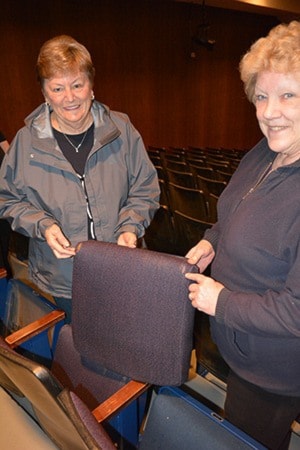The REM Lee Theatre Alive Society is pumping up its fundraising efforts to replace the theatre’s worn, uncomfortable seats and improve accessibility.
The society raises funds for the theatre, owned by the school district which can only invest a limited amount of money into it because its priority must be the students, said Nancy Stone Archer, REM Lee Theatre coordinator and REM Lee Theatre Alive secretary.
Of all the shows and presentations put on at the theatre, 72 per cent are community presentations and 90 per cent are put on by local non-profits, making the theatre truly a “grassroots community-use space.”
The theatre needs the support of the community in its upkeep, commented Stone Archer.
“We need the community to love the theatre,” she said.
In the last seven years, the district has spent an average of $118,000 per year to run the theatre, including paying for one full-time employee and one part-time employee who together do all the non-theatrical tasks for 10 months of the year, said Stone Archer. Since 2000, Theatre Alive has raised more than $200,000 for upkeep, an average of more than $17,000 a year.
Archer said the choice of what to replace or repair has been done on a greatest-need basis with no overall plan in place.
The seats have been repaired over the years, but it’s just a piecemeal effort that doesn’t last long, said Archer.
And costing $85 each to fix, the theatre can only afford to repair 10 seats each year, she added.
New seats for the whole theatre will cost about $300,000.
Taking a look at the seats in the theatre, it’s easy to see the wear and tear from usage, the unravelling seat upholstery, worn metal seat backs, scuffed wooden chair handles.
While sitting in the theatre for an hour or so might not be too bad, when it’s a longer performance of three or four hours, audience members will come out and tell Stone Archer that the seats are uncomfortable.
Another issue is that the building was not designed for the disabled, meaning that they can only enter through the side door and can only get to the bathroom by going outside and around the building to the front, said Archer.
There is a small spot at the end of the middle front row for wheelchairs so they can sit next to friends and family.
There needs to be a space for a wheelchair then two seats and another space on the other side for a wheelchair to improve arrangements, said Stone Archer.
It would be good to have space for wheelchairs at the back of the theatre too for those who do not want to sit in the front, she added. The theatre society is also looking into getting a lift put in to make the back row accessible to wheelchairs, said Stone Archer.
Many other parts of the theatre also need to be replaced.
Lights are another item on that list and the school district is looking into getting new LED ones to save on energy costs which are quite high, said Stone Archer.
What’s needed is LED lights that will dim but they’re a new product so they do dim but then when they turn on they’re suddenly very bright, too sudden for people who have been sitting in the dark, she added.
New lighting is also needed downstairs in the foyer.
The carpet there is old and fraying and will cost $30,000 to replace.
The society wants to hire a professional theatre consultant who could make a long-term plan for the theatre’s needs and repairs and figure out how to make the most of the money the theatre has.
It takes time to get a consultant and to get to the point of putting new seats in, which Stone Archer is thinking will be done, if all goes to plan, in the spring of 2018.
